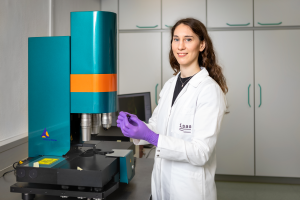The term omics refers to the holistic characterisation of all genes (genomics), lipids (lipidomics), metabolites (metabolomics) or proteins (proteomics). Omics data are an important starting point in precision medicine, because they provide insights into disease processes and possible therapeutic approaches.
Nowadays, analytical methods, including mass spectrometry, deliver increasingly more sensitive, more specific and faster measurement data. In order to analyse these large and in the future even more complex, amounts of data on corresponding genes, metabolites and proteins adequately, new bioinformatics strategies are required.

© ISAS / Hannes Woidich
Omics data provide information on biological networks in diseases
The junior research group Multidimensional Omics Data Analysis (MdOA) aims to develop open source software for data analysis. Furthermore, the researchers want to process and visualise the measurement data using biostatistical methods and machine learning – so that the data can then be interpreted in cooperation with experts for health research and clinical application. To do this, the scientists at ISAS first link individual omics data sets with each other and with information from clinical studies, databases and scientific publications. The findings from their multidimensional data analyses can be used, for example, to reveal biochemical pathways – actions between molecules in a cell – that interact with each other as biological networks. Uncovering these networks provides important information for individual strategies for the prevention, diagnosis and therapy of diseases. Thus, the researchers can identify potential biomarkers, for example for the prognosis of cardiovascular diseases or for monitoring the progression and therapy of chronic inflammatory bowel diseases. In addition, they can use the omics data to develop mathematical models that will assist physicians with diagnostic and therapeutic decisions in the future.
MdOA is a cooperation with BielefeldUniversity based on the Jülich model. Prof Dr Robert Heyer holds a professorship in bioinformatics at Bielefeld University, and heads the MdOA research group at ISAS.







